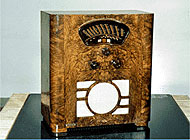Captured for posterity – the rich heritage of recording machines

Switzerland's national audiovisual museum in Montreux, the Audiorama, has gathered together the most comprehensive ever collection of recording machines for the exhibition: "Play Record Stop".
The exhibition, which runs for two years, takes the visitor through over a century of innovation as it maps the key moments in recording history. The machines not only bear testimony to technical breakthroughs, but also show how recording technology responded to and influenced social and cultural changes.
“Every piece of equipment has a fascinating story,” says Philippe Guillaumin, president of the Audiorama Foundation.
“It’s absolutely essential to show how this equipment evolved. Many of the pioneers of radio and television in Switzerland are still alive, and we can learn a lot from them,” he told swissinfo.
When they first appeared, audio cassettes, video recorders, camcorders, and computers were revolutionary. Now they are integral parts of our life. Many of the exhibits – the first Philips colour televisions, the early video recording machines of the 1970s, ancient gramophones – are anchored in our minds as important symbols of a particular era.
What may surprise many visitors is the important role the Swiss have played in audiovisual history. That becomes apparent as soon as one enters the museum – the first exhibit is the transmitter that, in 1922, made the first ever radio broadcast, from Lausanne.
“French-speaking Switzerland was predestined to have such an exhibition,” says Michel Baud, of the Audiorama.
“Switzerland played an extraordinary role for such a small country. Names like Kudelski, Studer and Revox became known throughout the world. The Studer multi-track machine was the Rolls-Royce of the recording studio,” he told swissinfo.
Pride of place, though, goes to the Kudelski Group, this year celebrating its 50th anniversary. It has lent many priceless machines to the Audiorama, many of which have never been seen in public before.
These include a machine used by Neil Armstrong on his Apollo 11 voyage to the Moon, another used by the FBI for espionage, and a data-recording contraption that was fitted to French naval torpedoes.
But the star of the Kudelski show is undoubtedly its best-known machine – the Nagra, and specifically the Nagra III, a machine that, for many years, no radio journalist could do without. Nagra means “it will record” in Polish, and it continues to fulfil that function to this day.
“The story of the Nagra is fantastic. It’s a Swiss product which virtually every radio journalist has used at some point,” says Guillaumin.
The museum leaves no stone unturned in its quest to trace the evolution of our quest to record sound, improve its quality and make it accessible to everyone.
There is the paleophone, developed in 1877 by Charles Cros, whereby sound vibrations were engraved on a hand-turned metal cylinder. That invention coincided with Thomas Edison’s phonograph, and they were followed by the gramophone of Emile Berliner.
It was not long before recording machines became commercial products – albeit only for the privileged few. The gramophones, and later the radio receivers, were transformed into magnificent pieces of furniture, the centrepiece of any home lucky to have one.
“These were luxury items. It could not be plain or banal. It had to be beautiful,” Baud says. “It’s fantastic to see the effort and craftsmanship that went into this equipment in those early days.”
That equipment was made to last. Now we know that our mass-produced recording machines will be obsolete in a matter of years, such is the speed of change.
Play Record Stop, with its 560 exhibits, traces the shift from cylinder recordings to disks, from magnetic tape to CDs, from analogue to digital.
Along the way, the visitor will see rarities like Phryrnis No. 1, an art-nouveau acoustic horn produced in 1908; a 1927 Lorens machine, which used a steel tape, intended for use in the cinema; and the first slow-motion machine, developed by Ampex in 1969.
“It’s important to see this evolution to understand why we’re where we are today,” Baud explains.
The Audiorama, which is housed in what used to be the Grand Hotel in Territet, opened its doors 21 years ago with the aim of preserving Switzerland’s rich audiovisual heritage.
by Roy Probert

In compliance with the JTI standards
More: SWI swissinfo.ch certified by the Journalism Trust Initiative
You can find an overview of ongoing debates with our journalists here . Please join us!
If you want to start a conversation about a topic raised in this article or want to report factual errors, email us at english@swissinfo.ch.